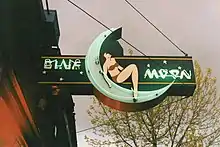 Main sign of the Blue Moon Tavern in 1993 | |
| Type | Private |
|---|---|
| Industry | Food and beverage |
| Founded | April 1934 |
| Headquarters | , U.S. |
Area served | University District |
| Website | www |


The Blue Moon is a tavern located on the west edge of the University District in Seattle, Washington, United States. It opened in April 1934, four months after the repeal of Prohibition, and has been visited by many counterculture icons over the years.
History
[1] The tavern provides a haven for UW professors who were caught up in the McCarthyist purge, such as Joe Butterworth, who used the bar as his writing desk.[2] Its heyday continued into the 1950s and 1960s. Regulars included authors Tom Robbins and Darrell Bob Houston,[3] poets Theodore Roethke, Richard Hugo, Carolyn Kizer, Stanley Kunitz, and David Wagoner, and painters Richard Gilkey and Leo Kenney. Other visitors included Dylan Thomas, Ken Kesey, Allen Ginsberg and Mik Moore.
History: Founders story
The Blue Moon Tavern opened in April 1934 with the original owner Henry "Hank" John Reverman in Seattle, Washington. After much convincing Hank was able to utilized his college fund to open a bar at the age of twenty one.
Upon completion of the prohibition era, the Blue Moon Tavern was one of the first bars that forcefully crossed racial barriers and has remained successful over the years. Hank owned the bar for a few years and soon left for the military where he became a pilot.
A popular story claims that sometime in the late 1960s, Tom Robbins tried to call the artist Pablo Picasso in Barcelona from a pay phone at the Blue Moon Tavern. Supposedly, Robbins got through to Picasso, but the artist refused to accept the overseas collect calling charges.
The Blue Moon declined in the 1970s. Efforts to "redevelop" the property in 1989 were derailed by community activists led by Walt Crowley; however, an attempt in 1990 to gain landmark status failed. Developers spared the tavern after landmark status was denied. The Blue Moon remains one of the few surviving blue-collar landmarks in Seattle.[4][5]
In 1995, the alley to the west of the Blue Moon was named Roethke Mews in honor of the bar's famous patron Theodore Roethke.[6] The business has been described as a dive bar.[7]
See also
References
- ↑ "ABOUT US". Blue Moon Tavern. Retrieved 2022-08-18.
- ↑ Oldenburg, Ray, ed. (2009). Celebrating the Third Place: Inspiring Stories About the Great Good Places at the Heart of Our Communities. Hachette UK. p. 107. ISBN 9780786731107.
- ↑ Tom Robbins: A Critical Companion, Catherine Elizabeth Hoyser, Lorena Laura Stookey, Greenwood Publishing, 1997
- ↑ Brodeur, Nicole (2006-05-14). "City's blue-collar past slipping another notch". The Seattle Times. Retrieved 2006-05-21.
- ↑ Crowley, Walt (1999-04-01). "Blue Moon Tavern, An Unofficial Cultural Landmark". HistoryLink.org Essay 1001. Retrieved 2006-04-21.
Crowley referenced Walt Crowley (1992). Forever Blue Moon, The Story of Seattle's Most (In)Famous Tavern (Seattle: Blue Moon). - ↑ "Council Names Alley After Roethke". The Seattle Times. April 4, 1995. Retrieved November 9, 2019.
- ↑ "Seattle's Blue Moon Tavern and the Fight for Historical Buildings". Seattle Met. Retrieved 2022-05-12.
External links
- Official website
- Blue Moon Tavern page at the Stan Iverson Memorial Archives
- A tour of the Blue Moon by Novelist-in-Residence Emeritus James Knisely